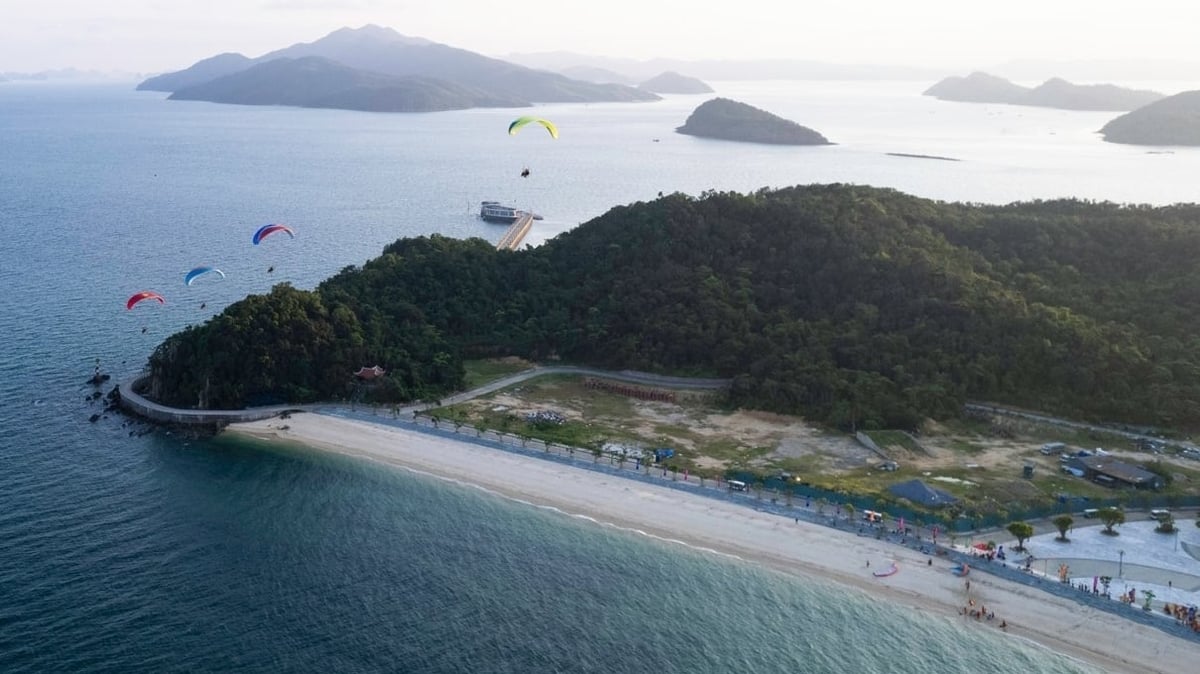November 9, 2025 | 09:03 GMT +7
November 9, 2025 | 09:03 GMT +7
Hotline: 0913.378.918
November 9, 2025 | 09:03 GMT +7
Hotline: 0913.378.918
When Quang Ninh officially approved the Ecotourism Development Project in the eastern protection forests in early June 2025, many envisioned a promising “green” tourism landscape. These forested areas, long regarded as the “lungs” of the province, are set to become immersive spaces for nature-based, cultural, and economic experiences - while still fulfilling their vital role in conservation and nurturing of the primary ecosystem.
With nearly 1,700 hectares of protection forest scattered across eastern districts such as Dam Ha, Hai Ha, and the former Binh Lieu, the project aims to establish 4 routes and 19 ecotourism sites. These will be developed by leveraging existing infrastructure, including patrol roads and local footpaths.

Visitors explore the primeval Doi (scientific name: Michelia tonkinensis A. Chev) forest in Ky Thuong commune, Quang Ninh province. Photo: Nguyen Thanh.
This marks a strategic turning point, as for the first time, Quang Ninh has boldly allowed up to 5% of forest land to be used for tourism infrastructure - within a strictly regulated conservation framework that prohibits forest conversion and protects the natural landscape and ecosystem integrity.
Currently, Quang Ninh boasts a rich and diverse forest ecosystem encompassing special-use forests, protection forests, headwater forests, landscape forests, coastal limestone mountain forests, and riverine mangroves. Forest areas like Yen Tu, Truc Bai Son, Ky Thuong, and the blooming lat trees in Binh Lieu have long been renowned among biological researchers. However, for many years, the ecotourism potential of these forests has remained largely untapped.
Mr. Vu Duy Van, Deputy Director of the Quang Ninh Department of Agriculture and Environment, noted: “We see forest tourism as a sustainable economic development pathway that aligns with current trends and fosters a close connection with nature. However, the core issue remains how to develop without disrupting the forest ecosystem. To achieve this, clear planning, strict oversight, and the selection of capable and conscientious investors are essential.”
According to Mr. Van, projects will only be approved if they demonstrate a development plan that integrates forest protection and growth. Even within the 5% land allocation for infrastructure, businesses are strongly advised to use no more than 2%, focusing on existing clearings or areas along established footpaths and community trails. All construction must harmonize with the natural landscape and must not disturb the ecological balance.
A recent example of this new direction is the ecotourism project on Da Dung island in Dam Ha commune, led by Bao Nguyen Investment and Development Joint Stock Company. As a pioneering initiative, the project spans 66 hectares, including 38 hectares of natural forest. The investor has designed a resort space that blends harmoniously with nature, strictly avoiding forest conversion or concrete construction. Instead, the project uses wood-based architecture, thatched roofs, and locally sourced stone, ensuring minimal impact on the natural environment.

Da Dung island ecotourism area in Dam Ha commune. Photo: Nguyen Thanh.
It's not just large enterprises that are joining the movement; small-scale and local startup models are also joining the movement. In Ky Thuong Commune, Am Vap Farm's agricultural ecotourism model linked to forest conservation is drawing particular attention.
Mr. Ly Tai Ngan, Director of Am Vap Farm, shared: “We don’t do mass-market tourism. Each forest walk is a storytelling journey about the history of the tram and lat trees, or the forest-preserving customs of the Dao people. Visitors don’t just come to sightsee; they leave with a deeper appreciation for nature and the ancient forests.”
The Eastern Quang Ninh protection forest ecotourism project is more than just a green light for businesses to operate in the forest. It represents a major policy shift, reflecting a new mindset in natural resource management.
Mr. Vu Duy Van stated that the Department will work closely with local authorities, forest rangers, and relevant agencies to strictly monitor project implementation. “We will not compromise with any acts of deliberate deforestation or illegal construction. At the same time, we are committed to supporting investors who are genuinely dedicated to nature and community.”
Quang Ninh has seen years of success with coastal and spiritual tourism models, and now forest tourism is emerging as a new strategic focus. If properly invested in and strictly managed, forest tourism could become a powerful driver for green tourism development. Forests are not only ecological bastions—if utilized wisely, they are also a sustainable economic resource.
Translated by Phuong Linh

(VAN) The development of green, circular, and organic agriculture is becoming an essential direction for the Mekong Delta, helping farmers cut costs, boost profits, and build a sustainable production system.

(VAN) Eighty years of agriculture and environmental development in the Mekong Delta tell a story of constant adaptation and transformation - all driven by the shared goal of harmonizing production with environmental protection.

(VAN) Sustainable coconut cultivation is the key to achieving balance among three pillars: economic efficiency, ecological safety, and consumer trust.

(VAN) A wood pellet factory has been supporting forest growers certified under FSC standards to improve their income and promote sustainable forest protection.

(VAN) Associate Professor Dr. Pham Anh Tuan emphasized that clearly identifying target groups, production scale, and consumer markets is key to ensuring the sustainable development of Viet Nam’s coconut industry.

(VAN) More than 400 experts from domestic and international organizations attended the ACT Con 2025 conference, which aimed to connect technology developers with frontline conservation teams.

(VAN) Food irradiation technology is an innovative solution that extends shelf life and acts as a ‘golden visa’ enabling Vietnamese agricultural products to access the world’s most demanding markets.